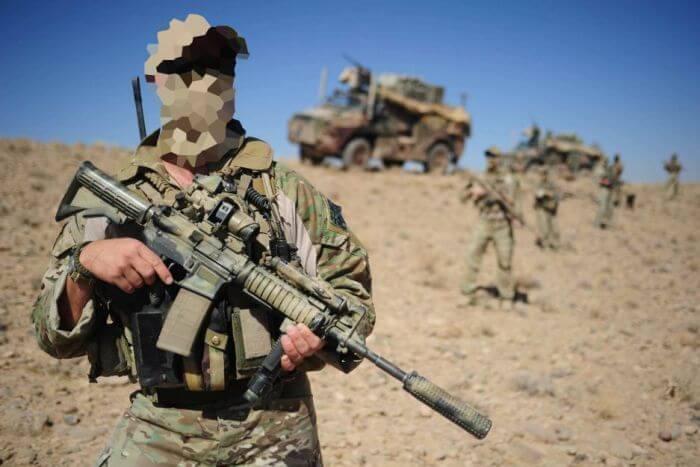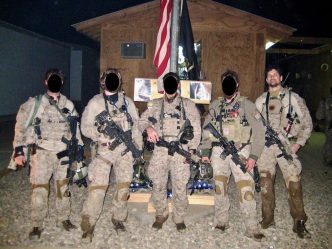The Special Air Service Regiment, also known as SASR, is a highly skilled and elite unit of the Australian military. Drawing upon the lessons learned by the British SAS and the experiences gained by Australians during World War II, SASR incorporates the best practices of both special commando units and highly efficient independent companies that excelled on the battlefields of the South Pacific.
Introduction
The task of providing operational coverage for the entire national territory of Australia, a continent, is a delicate task for any special forces unit. Fortunately, the smallest and most remote continent has been spared the destruction of physical destruction caused by world conflicts throughout history. However, Australian troops have still experienced the horrors of war from Gallipoli to Normandy, and from the Burmese and Vietnamese jungles to the Iraqi and Afghan deserts. In these conflicts, Australian soldiers have proven themselves to be skilled and reliable warriors.

Mission
The unit has two main tasks: strategic surveillance and reconnaissance of the territory of Australia, and the planning, preparation, and execution of counter-terrorism activities.
In the role of strategic surveillance, the SASR has developed a successful approach using small patrols that are able to infiltrate deep behind enemy lines and gather intelligence on the size, movement, and strength of the enemy. These patrols try to avoid direct combat whenever possible and rely on the advanced communications systems used by the SASR to call for air, artillery, or other forms of support when needed. The SASR’s patrols are able to quickly and effectively enter enemy-controlled areas by land, air, and sea (including submarine transport) and have proven capable of covering large distances in both rainforest and desert environments, day and night.
In its counter-terrorist role, the SASR specializes in tasks such as hostage rescue, including on vessels. In these situations, SASR operatives are trained to use maximum force against their adversary. The SASR is organized into three squadrons that rotate between strategic reconnaissance and counter-terrorist roles every 12 months, with two squadrons typically in a strategic-reconnaissance role and one in a counter-terrorist role. Every third year, each squadron switches to a specific counter-terrorist regime of work and organization. The SASR also has two tactical assault groups, one formed from the SASR and 4 RAR (Tactical Assault Group West) and the other from the 1st Commando Regiment (Tactical Assault Group East).

History
The Royal Australian Special Air Service (SASR) was formed on June 25, 1957, as the 1st Special Air Service Company (1st SAS Company) of the Royal Australian Regiment. Over the next six years, three light squadrons were added to its structure, and it reached regimental status on August 20, 1964, when it was officially renamed the SASR. The SASR saw its first combat action in 1965 as part of the Australian military contingent in Borneo during the conflict with Indonesia. Australian special forces worked alongside their New Zealand and British counterparts to counter Indonesian military infiltration in Malaya.
The SASR also participated in the Vietnam War. In April 1966, the 3rd Squadron was deployed there as part of the 1st Australian Strike Group (1st ATG). The SASR’s role was to conduct strategic reconnaissance on behalf of Australian forces in the area. Squadrons rotated through the Vietnamese rainforest every 12 months until October 1971, when the last squadron was withdrawn. The Vietnamese communist forces gave the SASR operatives the nickname “rainforest phantoms,” a name that was well-deserved due to their success in the conflict. Official data from the SASR claims that the ratio of enemy to friendly losses was an impressive 1 to 500.
Following the withdrawal from the Vietnam War, Australia’s military doctrine shifted away from “advanced defense” and towards the defense of the continent from enemy attack and infiltration. The SASR played a key role in developing the Army’s ability to conduct patrol operations in northern Australia. In the early 1970s, the SASR was also assigned the task of developing elite counter-terrorism capabilities, including the ability to respond quickly and effectively to terrorist actions in Australian cities and hostage crises on ships, oil platforms, and airports.

Over the past 10-15 years, SASR operatives have participated in several peacekeeping operations around the world, including in Somalia. The largest percentage of SASR losses during this time period occurred during training. The worst incident in SASR history took place on June 12, 1996, near Townsville, where 15 SASR commandos and the pilots were killed in an aerial collision between two S-70A Blackhawk helicopters. In 1998, SASR operatives, along with the New Zealand SAS, were deployed to Kuwait as part of Operation Desert Thunder, where they were responsible for searching and rescuing the crews of allied aircraft that had been shot down by the Iraqi Air Force.
From September 1999 to February 2000, SASR forces played a significant role in the peacekeeping operation in East Timor. In October 2001, the Australian government deployed a battle group centered around an SASR squadron to Afghanistan to fight against the Taliban and Al-Qaeda. SASR squadrons rotated in and out of Afghanistan every 6 months. In addition to strategic reconnaissance, the Australians also conducted a series of offensive operations against Taliban forces in eastern and southern Afghanistan as part of Operation Anaconda. Australian special forces were withdrawn from Afghanistan in October 2002 but were sent back again in September 2005.
Domestic security and its controversies
SASR troops played a key role in security during the 2000 Sydney Olympics, with two squadrons activated for counter-terrorist operations. The SASR’s anti-terrorism role has been particularly emphasized since the September 11th attacks on the World Trade Center in New York. The SASR was also responsible for implementing security measures during the Rugby World Cup in Australia in 2003.
Currently, the SASR provides personnel and resources for one of the two tactical assault groups (the western one). In August 2001, the Australian government deployed the SASR in a counter-terrorism operation in the waters around Christmas Island, where the ship Tampa was believed to be carrying terrorists. When the commandos boarded the ship as it entered Australian territorial waters, they found only refugees attempting to enter the country illegally.
Organization
The backbone of the organizational structure of the Special Air Service Regiment consists of three assault squadrons with 80 members each. In addition to the assault squadrons, the organization also includes the 152nd liaison squadron, the logistics support squadron, and the operational support squadron (the task of which is the selection of personnel and their training). More than one-third of the operatives have sniper qualifications. All members of the SASR must go through basic parachute training as well as specialist training for air, water, or motorized insertion into areas under the control of opposing forces. A very small percentage of SASR operatives have the “lowest” level of specialist training.

The majority of the regimental composition is highly qualified by numerous combat courses that have earned them the title of “specialist” so that they can provide the widest possible support in any type of special operations. These specialties include communication, technical-mechanical, medical, logistics, and many others specialties. Within each attack squadron, there is a division into four operational platoons. These are the headquarters platoon, airborne platoon, amphibious platoon, and mechanized platoon.
SASR has its headquarters at the Campbell Barracks, while there are also has bases in Swan Bourne, Perth, and Western Australia. As part of the Royal Australian Infantry Corps, SASR is a crucial component of the Australian Defense Forces.
Tactical assault groups
The Tactical Assault Group (TAG) is Australia’s primary counter-terrorism unit on domestic soil, with two groups established – one in the east and one in the west. These groups are trained to carry out offensive counter-terrorism actions on Australian soil, with a particular focus on crisis situations involving Australian hostages. Australia’s first major encounter with modern terrorism was the bombing of the Hilton Hotel in 1978, which demonstrated that terrorism had reached Australian shores. In response, plans were announced to create a special AT group within the SASR, similar to the British SAS Pagoda teams. The first such team was named TAG-W, and TAG-E was established in 2002 due to increasing needs, capabilities, and potential.

Each of the TAG groups is responsible for the surveillance and protection of specific geographical areas. Both groups are composed of elite members from units under the command of SOCOMD and are trained and equipped to rapidly and simultaneously respond to any terrorist incident on Australian soil. TAG-W is responsible for the area of Western Australia, South Australia, the Northern Territory, and several northern island groups.
It is primarily composed of members of the SASR, and due to the SASR’s reputation as Australia’s most elite special forces unit, TAG-W is considered the “senior” of the two groups. TAG-E is responsible for New South Wales, Victoria, Queensland, Jervis Bay Territory, Tasmania, the Capital Region, and southern island groups. It is made up of members of 4.RAR and Navy CDT (Clearance Diving Teams).
Training and selection
Candidates for the SASR regiment are selected from the ranks of the Australian Armed Forces. Selection is voluntary and is based on a rigorous three-week selection process that tests candidates’ physical and psychological endurance, as well as their ability to work effectively in small and large teams. Those who successfully complete the selection process go on to complete an 18-month candidate course, after which they earn the title of “junior operator.”
Officers who volunteer for the SASR must only complete the basic course to qualify for the unit. Their specialty is in planning and administration, and they are generally not allowed to attend the specialist courses attended by other operatives. Instead, they receive additional specialized training within their basic unit. New team commanders are carefully mentored and monitored by their sergeants, as well as senior and senior commanders.
Generally, junior operators may serve in their first unit for 2-3 years, but many return to the SASR later in their careers. Soldiers can serve in the SASR until the end of their military careers (if they meet the criteria), which often includes several years as instructors. On average, only 5-10% of registered candidates are able to successfully complete the rigorous 18-month training. The rest return to their basic units. Serving in the SASR is not easy, and promotions for soldiers are relatively slow. When they earn their brown berets, all soldiers are given the rank of “trooper,” which for many means a demotion from their previous rank in their former units.
Members of the SASR who have completed selection and basic training are easily identified by their sandy-colored beret and the distinctive badge featuring Excalibur, the flaming sword, and the words “Who Dares Wins.”
SASR official
In contrast, officers are not demoted in rank when they join the SASR. Despite the reduction in rank, SASR soldiers do receive a number of other benefits, including the highest pay of any member of the Australian Armed Forces. Since its inception in 1954, the SASR has lost more members during training than in combat operations, a testament to the rigorous and dangerous nature of its training.
Gear
SASR operators are equipped with a variety of weapons systems depending on the needs of the mission. This means that the SASR has access to a range of weapons, including:
- M4A1 Carbine (designated as the M4A5 in Australia) – primary weapon
- M4 (designated as the Mk 18 CQBR)
- Sig-Sauer MCX
- Heckler and Koch MP5
- USP Tactical – secondary weapon
- Glock 19
- Heckler and Koch HK417
- SR-25 Marksman rifle
- Mk 14 Enhanced Battle Rifle
- Mk 48 Maximi Modular
- MAG 58
- Para Minimi
- SR-98
- Blaser Tactical 2
- Barrett M82A2
- M72 Rocket
- M3 MAAWS
- FGM-148 Javelin
- M2-QCB Browning
- Mk 47 Striker
- Flashbang devices and fragmentation grenades













